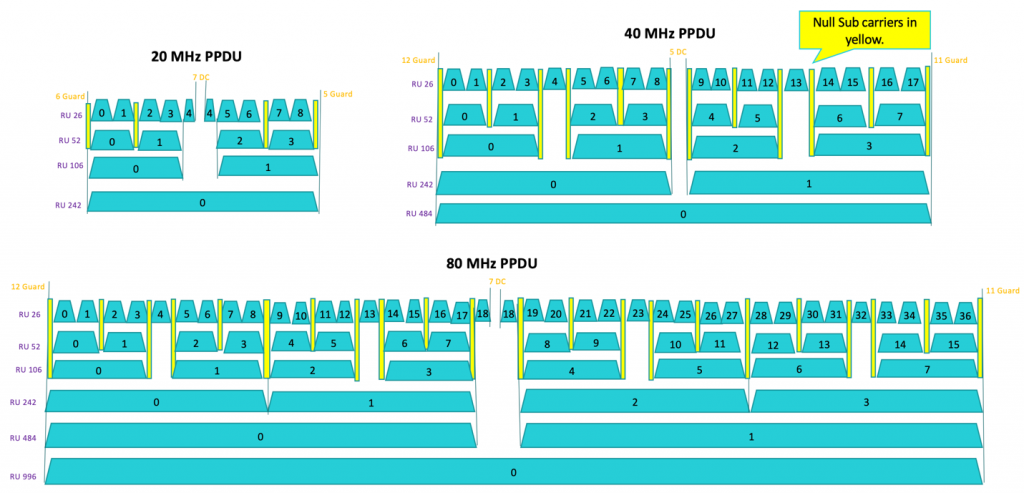OFDMA (Orthogonal Frequency Division Multiple Access) is arguably the most significant feature of Wi-Fi 6. In a nutshell, it allows multiple clients to transmit or receive from an Access Point at the same time by sharing available bandwidth. OFDMA’s spectral efficiency improves transmission latency or delay in RF environment, which has moderate to high congestion level. Additionality, it will also increase throughput in certain Wi-Fi 6 deployments due to reduction in collisions and contention time.
Let’s look at various concepts of this technology at length. OFDMA allows sub-carriers in a channel bandwidth to be grouped into smaller portions called “Resource Units” (RU). These individual RU’s are assigned to different stations, which allows Access Points to serve them simultaneously during uplink and downlink transmissions.
These Subcarriers are further split into granular component called tones. It simply means that a RU consists of a group of tones. So how do we derive and visualize RU’s?
In Wi-Fi 6, subcarrier spacing is 78.125 KHz, which is four tmes narrower than 802.11ac’s 312.5 KHz.
Based on this, we can build a formula to calculate the number of tones for different bandwidths. i.e. Number of tones = (BW in MHz) ÷ (0.078125 MHz).
The above formula gives us total tones of 256, 512 and 1024 for 20MHz, 40MHz and 80MHz respectively.
Are all of these used for data transmission? Certainly, not. Few of them are DC (direct conversion), Guard and unused (Null Sub carriers) tones. Hence, we have usable RU tones of 26, 52, 106, 242 and 996, which includes data and pilot subcarriers.
To condense, a single RU consists of minimum 26 tones and maximum of 996 tones.
In relation to bandwidth, it’s quite visual from below diagram that each 26 tone RU corresponds to approximately ~2MHz, 52 tones to ~4Mhz, 106 tones to ~8Mhz and so on.
RU Locations with Channel widths
Resource Unit Map
Next up, we will establish correlation between RU’s and Channel bandwidth. The below table represents Subcarriers per channel width mapping. It basically shows the number of OFDMA users for a particular tone at any given bandwidth. In 80Mhz, a maximum of 37 users are supported with 26 tone RU’s. In 40Mhz, a maximum of 18 users are supported with 26 tone RU’s. Similarly, in 20Mhz, a maximum 9 users are supported with 26 tone RU’s. Fields with user value as 1 is a SU (single user) case, where whole spectrum is allocated to one user.

RU allocations can happen with a combination of tones. For example – if there are three stations associated, then the AP can assign 106 tones to the first two users and 26 tones to the third user. The AP can also assign 52 tones to the third user. These RU allotment decisions are dynamically made by the AP based on the client’s traffic type and its available amount for transmission. The AP learns the client’s buffer status by using a periodic sounding mechanism.
Latency sensitive real time voice and video applications are primary candidates for OFDMA.
Other applications involving large data packets can either choose MU-MIMO or SU transmission mode.
RU allocations within Channel Access
A Wi-Fi 6 AP still contends with non-Wi-Fi 6 stations for getting access to channels using EDCA.
EDCA provides contention-free access to the channel for a period known as Transmit Opportunity (TXOP), during which a station can transmit maximum frames.
RU allotments in both downlink and uplink directions are performed by the AP on a per TxOP basis.
During a TxOP, the AP can serve multiple Wi-Fi 6 users using single MU PPDU or data packet.
EDCA incorporates Access categories (AC) i.e. Voice, Video, Best Effort and Background. Hence, stations which needs to send data in the same access category are served together using Multi-user (MU) OFDMA packets. Stations with different AC tags are served using different MU data packets.
Do you have High density wireless deployment with latency sensitive application traffic? If yes, then now is the time to upgrade to Wi-Fi 6. It will also enhance IOT devices efficiency and performance in both 2.4GHz and 5GHz bands. OFDMA is an answer to issues like unavailability of network access and choppy voice or video in crowded places like Offices, Schools, Malls, Airports, Hospitals and even at homes with multiple streaming devices.
During these unprecedented times of social distancing, the significance of Wi-Fi is more than ever.
Cisco’s Wi-Fi 6 certified Catalyst 9100 Access Points (9130, 9120 and 9115) have full DL and UL OFDMA capabilities. In terms of client support, Intel, Samsung, Huawei and Apple are powered with Wi-Fi6 features.
Learn more about the Cisco Catalyst 9100 Access Points
Subscribe to the Networking Blog




Great read. A very comprehensive explanation about RU allocation.
Very well explained! Good read
Very well explained! Good read
Very detailed and insightful information on 802.11ax. Very helpful in understanding the Wifi-6 at protocol level.
Good read! Thanks for putting up there with this detailed level of information on RU allocation. Insightful!!
I had been looking info on RU allocation and I must say this is best one.
Very well written with attention to details. I would love to learn about the significance of DC bands, guard bands etc. May be subject of your next blog?
That’s a good idea AJ 🙂
Just to add little about these bands – They fall under Unused subcarrier category, which are basically not used for data or pilot transmissions. Pilot subcarriers are used for phase information and parameter tracking.
Nice article, Shreyas. Keep it coming.
It will be good if you can add empirical data you may have collected – esp. those that show improvement in QoS of the WLAN network as a whole.
Good explanation.
Please correct: Number of tones = (BW in MHz) ÷ (0.078125 MHz)